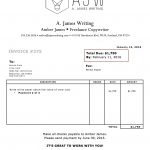It’s not a sexy topic: the invoice. But every freelance professional needs to have it. You could even say we rely on the invoice. How else are we going to get paid? Instead of you having to do what my colleagues and I had to do (figure it out through trial and error), I’m going to show you what a freelance invoice looks like. We’ll use the Classic 6 Questions to dissect it:
- To whom do you send it?
- What information is included?
- Where is pretty much covered under whom.
- Why do you need to include all the things I’m suggesting? These will be discussed in-line with the topics.
- When do you send the invoice?
- How do you send the invoice?
To Whom You Send the Invoice
Send it to at least two people: your primary point of contact and an administrator in their office. The reason I recommend sending it to at least two people on the client’s side is because people lose things. I’ve worked with at least three clients who’ve forgotten about my invoice. It was only after I followed-up with them a month later that they said “Oh, um, right. Can you send it again? It got lost in my email. So sorry.” Sure. I email them the invoice again, they confirm receipt, and then three or four more weeks later my check arrives in the mail. Not cool. By sending it to two people AND being diligent about following-up, you’re less likely to have overdue invoices.
Sometimes your client is a solopreneur and there literally isn’t anyone else to send it to. In those cases, cool, send it to that one person. Be sure to follow-up with them on the status of your invoice the day it’s late. Not a week later, the day it’s late. Don’t let it go any longer. If you’re not good at asking people for money, here’s a way to phrase your inquiry:
Hi James,
I wanted to check on the status of my invoice for the editorial calendar project. I emailed the invoice to you on January 10th. Can you tell me when I can expect payment?Thanks,
Amber James
What Information to Include
Here are examples of my analog invoice and my Freshbooks invoice:
The key information to include in your invoice template is:
- Payment amount
- Payment due date
- How to pay you (check in the mail, Paypal, credit card via a digital platform like Freshbooks or Pancake)
- What you’re being paid for
At a minimum, you’ll want to include these bits of information because they are directly related to you receiving the correct payment for your work. Make this information prominent, put it in bold, make it colorful. However you do it, make the information clear. Credit for the due date innovation goes to freelance business attorney Katie Lane of Work Made For Hire.
When to Send the Invoice
Depends on the project. If you’re working on a longer-term project like the one in my example, you’ll likely end up billing in parts. For this example project, there are three invoices planned. The first invoice is sent before work begins / as soon as the terms and timeline are agreed upon, the second goes out after the first draft is done and submitted, the third is sent after the first revision is completed. Why? So that way your invoices (and thus, your receiving payment) are dependent upon YOUR actions, not those of your potentially forgetful client.
If you’re working on retainer for a client (good for you!) you’ll likely bill them monthly. If you’re doing a consulting project you could ask for 100% up-front and invoice beforehand. For a large project like my example, you could also invoice for 50% up-front and the rest after the first revision. For smaller projects, I send my invoice after the work is sent, revised, and accepted by the client. These projects are usually pretty short-term, so waiting until it’s finished (two weeks max) is no hardship.
Bear in mind, you can invoice for whatever percentage of your fee, whenever you want, as long as you’ve communicated the schedule to your client as part of the project plan. Some practices don’t always feel comfortable to the client, however. For example, invoicing for 100% up-front, with a first-time client, for a many-months long project. Just food for thought as you choose your invoicing practices.
How to Send the Invoice
When I started freelancing in 2009, I did the first method mentioned above: Word doc invoice template, saved as a PDF, attached to an email, and sent to the client. Then my colleague, Mike Russell, told me about Freshbooks. At first I balked at having to pay $19.95 per month for the privilege of sending invoices that I could just send for free. Then I realized how lovely it could be to accept credit card payments (read: get paid faster), link the whole thing up to Gusto (formerly Zen Payroll) for all the tax-related stuff, and keep track of my business account expenses. Those were some of the selling points that made me convert to Freshbooks. Oh, it also allows you to set up automatic late payment reminders. That feature has come in handy for me more than once.
There are other services out there that do what Freshbooks does. I’ve heard from CC: PDX prez Mahesh Mohan that Pancake is also a good option for invoicing. If you have no interest in paying to send your invoices, I’ve heard of no stigma around the tried-and-true PDF attachment method. When you decide it’s worth it for you to spend money on this sort of service, know that Freshbooks and Pancake are used and recommended by members of the Conclave.
The invoice is amazing. It is that which enables us to get paid for all our creative works. Learn it. Live it. Love the invoice! It can be pretty or plain, simple or elaborate, but it MUST communicate those four things clearly. As an ending thought, I’d like to leave you with some wisdom from money coach Shell Tain. She strongly recommends sending your invoices and following-up in a timely fashion because if you don’t, your clients will get the impression that you don’t care about being paid. In turn, they won’t care about paying you. And we can’t have that.
What additional questions do you have about the miraculous invoice? What methods do you use for billing?


